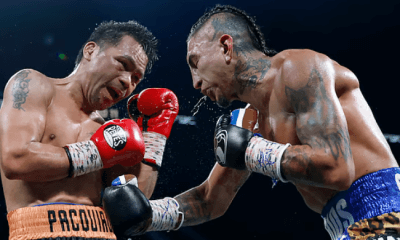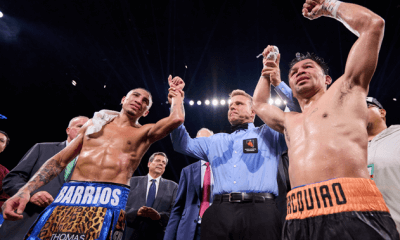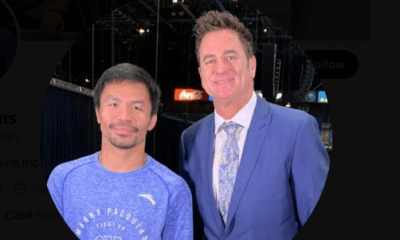Articles of 2005
Gypsy Joe Harris: Career (And Life) Interrupted
For just about any normal mortal starting out in the rough and treacherous waters of boxing, it seems like progress is sometimes one step forward and two steps back. When a youngster enters a gym, they’ll often go in a little cocky and think they’ll master the sport in short order. However, after some black eyes, busted lips, getting deposited on the canvas a few times by a more experienced fighter, or even suffering some broken ribs, the reality of the school of hard knocks sets in. Thereafter, the superficial dreams of the easy road and the high life are supplanted by the blood, sweat and tears of a circuitous, bumpy apprenticeship.
In terms of the craft of the sport, for every move a counter exists. In kind, for every counter another move or counter is lurking. Learning to box usually starts with learning to jab, and that in itself is a challenge. Learning to properly jab an opponent can come in all shapes and forms. Dwight Qawi was a master at out-jabbing significantly taller opposition with an up jab. Larry Holmes had one of the best jabs in history. Ironically, when Holmes was in deep trouble during some of his toughest fights, it was because the opponent was able to time that jab and land a nasty right hand counter. Angelo Dundee said Sonny Liston could knock out an opponent’s teeth with the jab. Boxing is a complex art and a constant learning process. When you think you’re an expert and you know it all, something comes out of nowhere and surprises you.
Over the years, one of the most perplexing things for me to fathom is highly effective fighters who broke every fundamental rule in the book. Muhammad Ali and Roy Jones are two that come to mind. Ali leaned straight back instead of properly slipping punches. He dropped his hands, didn’t have his feet planted correctly, allowed fighters to pound away on him, and almost never brought his jab back to chin level as even novice amateurs are taught. Jones sometimes didn’t use the jab at all. He landed punches from bizarre, awkward angles with powerful impact.
Harry Greb might’ve been the greatest fighter of all-time. Films of Greb’s fights are unavailable, but by historical accounts, his style is best described as unconventional and sometimes heretical. Greb’s quirky style and massive punch output stymied and confused his best opposition. Greb threw out the textbook, and carved out perhaps the most unique and successful career in boxing history.
Sometimes it’s good to question authority, buck conventional wisdom, and think for yourself.
In the 1960s, another unusual but highly effective fighter appeared on the landscape. Unfortunately, his career didn’t reach the heights as those mentioned above, but he was certainly eccentric. Gypsy Joe Harris holds the distinction of being the only non-heavyweight contender to appear on the cover of Sports Illustrated. I have a copy of the June 19, 1967 magazine with Harris on the cover. Author Mark Kram effectively detailed the essence of Harris’ personality and ring style. I read it again after watching Ray Oliveira’s scary loss to our era’s biggest nonconformist, Emanuel Augustus, and couldn’t help but wonder what Oliveira was thinking when Augustus went into a bizarre dance and landed punches at will. At a higher level, Harris upset and confounded his more conventional opponents in the 1960s, and usually got away with it as well.
When fighters today enter the ring, it’s usually to rap music. When I watch film of Sugar Ray Robinson, I’m tempted to turn off the sound and put on classical music. If film of Harris ever becomes available to the general public, a psychedelic concoction or fusion of Jimi Hendrix’s “Electric Ladyland” and Miles Davis’ “Bitches Brew” would be most appropriate. Harris was improvisational, and that’s what made him unique and distinct. As trainer Willie Reddish said about Harris, “He don’t make plans, because he don’t know what he gonna do till he do it.”
Gypsy Joe Harris was a Philadelphia fighter, but not in the accepted mold of Joe Frazier and Bennie Briscoe. On the opposite side of the continuum, Philadelphia has produced wonderfully slick stylists like Jeff Chandler, Tyrone Everett, Harold Johnson, and recently deceased Jimmy Young. By all accounts, Harris didn’t fit into either category. Rather, he fit somewhere between Ali, Jones and Augustus. He is also elusive to categorize in terms of his weight class. Many list Harris as a welterweight, but he fluctuated between welterweight, junior middleweight, and middleweight.
Although it’s obvious that Harris’ ring style was different than Greb’s, both men actually had a lot in common. They lived by their own formless code, fought blind in one eye, often overwhelmed opponents with volume and strange angles instead of power, and died young. Greb acquired his injury several years into this career in the early 1920s, whereas Harris acquired his injury in a street altercation when he was eleven years old. Both men died of heart failure. Greb died on the operating table under anesthesia during nose surgery at the age of 32 in 1926. Harris died of cardiac arrest at the age of 44 in 1990 after several previous heart attacks and years of drug and alcohol abuse. Harris might’ve become one of the greatest fighters of all-time like Greb, but he never got the chance.
Harris started his professional career in 1964 with a third round knockout of Freddy Walker in Worcester, Massachusetts. Within two years, Harris had gained a reputation as a ring savant with a bag of idiosyncratic tricks. On October 10, 1966 Harris stopped tough, rugged, and brutal punching fellow Philadelphian Stanley “Kitten” Hayward in seven rounds at the Philadelphia Arena. Hayward had previously beaten Bennie Briscoe, Curtis Cokes, and superb stylist Dick Turner. Turner retired after his bout with Hayward due to a detached retina.
In 1967, Harris continued on his flamboyant journey. Gypsy Joe’s wild and audacious wardrobe might’ve made even Hendrix blush that year, and his nonpareil style astounded crowds and opponents just as Jimi did at the Monterey Pop Festival that year. On March 31, Harris decisioned Cokes over ten rounds at Madison Square Garden. Cokes was a textbook stylist, just as Eric Clapton was a precision guitarist. Cokes wasn’t referred to as “God” like Clapton, but Cokes’ jabs, crosses and hooks are what every traditional trainer would appreciate and endorse.
Testimony to Cokes’ abilities is that he went 2-1 against the great Luis Rodriguez from 1961-1966. In his last bout with Rodriguez on July 6, 1966, Cokes stopped Rodriguez in the fifteenth round. Rodriguez was one of the most underrated and classy boxers in history, and was only stopped three times in his 121 bout career. A natural welterweight, Rodriguez beat Bennie Briscoe and Rubin Carter, and fought four nip and tuck battles with Emile Griffith. If there was a truly fluid and smooth technician of the 1960s, it was Luis Rodriguez. It was like Clapton out-dueling Jeff Beck.
Cokes may have gotten the better of an all-time great like Rodriguez, but he was befuddled by Harris, just as Clapton was blown away when he first saw Hendrix perform onstage. Over ten rounds, Harris took Cokes to places he’d never been. The normally composed Texan was so confused that he might’ve felt like Timothy Leary spiked his water with LSD. Harris was a bad trip for Cokes, as if poor Curtis was floundering and hallucinating in a Hendrix purple haze. What worked with Rodriguez and other stellar opponents simply didn’t work with Harris. Cokes later exclaimed, “I couldn’t jab him. He don’t have a style. He just stands there and acts the monkey. I hit him a few times, but he’d just wobble and come back. He’s a tough kid. They got to give me a roomful of money to fight him for the title, and there ain’t enough to get me to fight him in New York.” The decision was unanimous, and Harris was officially on his way. Harris continued his winning ways for the rest of the year with wins of excellent opposition like our own Bobby Cassidy.
In 1968, Harris tallied one more win against Dick DiVeronica, and signed to face the great Emile Griffith. Griffith vs. Harris occurred in Gypsy Joe’s hometown at the Spectrum on August 6, 1968. Many expected Harris to provide Griffith with a very tough test, but Harris reportedly behaved and performed erratically throughout the contest. In the biggest fight of his life, Harris clowned his way to a decision loss. It was an unfortunate, misanthropic performance that left Philly fans disappointed. To be sure, Griffith was tough, strong, and effective. In the end, Gypsy Joe might’ve simply met his match, and found Griffith to be different than his best opponents of the past.
What Harris didn’t know at the time was that the Griffith fight would be his last. On October 11, 1968, doctors finally discovered that Harris was blind in his right eye. It was a secret throughout his career, and evidence as to how accomplished and innovative Harris was in the ring. He beat some of the best fighters of his generation with one eye, and often positioned himself so he could pick up the incoming punches without being handicapped by the bad blinker. Harris lost his boxing license, appealed several times, but never fought again. His career ended before his twenty-third birthday. His final record reads 24-1 (8 KOs).
It is well known that Harris drifted into drug addiction and alcoholism for several years after losing his boxing license. Not surprisingly, he held a series of odd jobs, but nothing really lasted. Harris was a gypsy at heart, and seemed to live for the moment. In his heyday, he wore several sets of outlandish clothes per day, sporadically worked as a bartender, never kept track of his money, and sometimes showed up at the gym drinking a mixture of milk and whiskey. His trainers and acquaintances would often look for him for hours, only to have him almost innocently appear on his own time clock to fulfill his training duties.
In the remaining years of his life, he was often homeless and on welfare. As mentioned above, years of dissipation took a cumulative toll, and his heart gradually gave out after a series of heart attacks. It’s a sad and horrible story, but as many have stated, Harris was a carefree sort and reportedly didn’t wallow in self-pity as he spiraled into his final decline. Even near death, he would appear at Philadelphia gyms and joke around with trainers and fighters. His destiny was to live fast and die young, and he was probably aware of his destiny all along.
Many boxing people have given us an idea about how good Harris really was. Perhaps the most notable observer of all is Philadelphia boxing history’s most significant and important promoter, J. Russell Peltz. Peltz is also the most prominent collector and distributor of Philadelphia boxing memorabilia. Peltz described Harris’ unique qualities just after Gypsy Joe died in 1990. “He did things in the ring that had not been done before or since. Gypsy Joe was a magician, very tough to hit. He was a very big attraction in Philadelphia.” Obviously, Gypsy Joe was something very special. As mentioned previously, footage of Harris exists, but is not available to the general public. Hopefully, someday the public will rightfully and cost effectively be given full access to Harris’ fights on tape, and we’ll be able to get a crystal clear picture about the prowess so many have talked about for decades.
-

 Featured Articles2 weeks ago
Featured Articles2 weeks agoResults and Recaps from New York Where Taylor Edged Serrano Once Again
-

 Featured Articles2 weeks ago
Featured Articles2 weeks agoResults and Recaps from NYC where Hamzah Sheeraz was Spectacular
-

 Featured Articles2 weeks ago
Featured Articles2 weeks agoFrom a Sympathetic Figure to a Pariah: The Travails of Julio Cesar Chavez Jr
-

 Featured Articles2 weeks ago
Featured Articles2 weeks agoPhiladelphia Welterweight Gil Turner, a Phenom, Now Rests in an Unmarked Grave
-

 Featured Articles3 weeks ago
Featured Articles3 weeks agoCatterall vs Eubank Ends Prematurely; Catterall Wins a Technical Decision
-

 Featured Articles5 days ago
Featured Articles5 days agoManny Pacquiao and Mario Barrios Fight to a Draw; Fundora stops Tim Tszyu
-

 Featured Articles3 days ago
Featured Articles3 days agoArne’s Almanac: Pacquiao-Barrios Redux
-

 Featured Articles1 week ago
Featured Articles1 week agoFrom the Boondocks to the Big Time, The Wild Saga of Manny Pacquiao’s Sidekick Sean Gibbons










